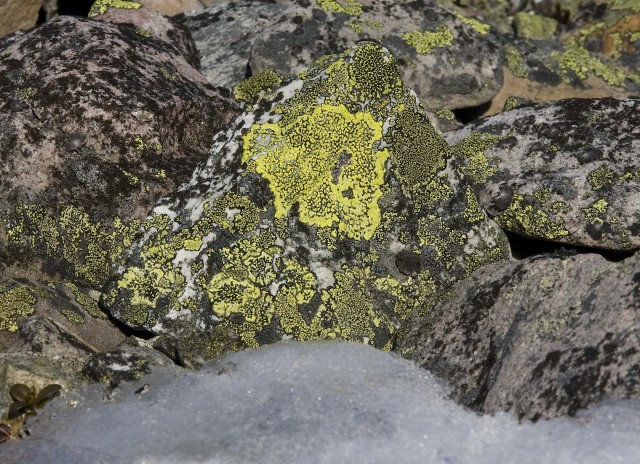Bears and life on stone
The silence is grand, but for a short while at the start of the summer you’ll be able to hear the Brambling, the Redwing, the Chiffchaff, the Willow Warbler and many other birds visiting for the summer.
 Siberian jay.
Siberian jay.
The Siberian jay (picture) is an example of a sedentary bird which can often grow accustomed to humans. It is relatively quiet but uses a variety of sounds nevertheless. Listen out for examples in this guide!
The best chance to see some of the many bears living here comes with the autumn arriving. Listen! Click on the image!
When bears awake in the spring the may have lost as much as 40% of their bodyweight.

Bears have good hearing. They will often rise up on their hind legs if they feel disturbed, to get a better view. They can run faster than any humanbeing.
 Bear excrement.
Bear excrement.
At a distance the blockhav of the Sonfjäll seem quite grey and lifeless, but when you get closer you will discover that stones and rock are covered in lichen. The most common is the green-yellow map-lichen. There is also Cladonia Stellaris, Iceland moss and grey and yellow-white reindeer lichen.

When the latest inland ice had melted approximately 9000 years ago, the ground started yet again being covered in growth. In the area around the Sonfjäll the vegetation is relatively species-poor. The reason for this is that the dominating rock, Vemdals quartzite, produces a course-grained and not very nutritious soil. It does not retain water well. Because of this and combined with the weather conditions, lichen-moors and lichen-rich heather moorland has become the most common types of vegetation.

The mountain birch has ravaged trunks. The low shrub, the dwarf birch was one of the first plants to grow after the ice-age.
Along the ravines leading up to the mountain, the herbal wealth and colour richness can be awesome.
 Alpine Sow-thistle.
Alpine Sow-thistle.
The forests of the national park are partly affected by logging dating to the beginning of the 20th century. Some parts have also been hit by forest fires several times. The scars left on the trees after such fires are called brandljud

Humans might have existed here for more than 8000 years! Read and listen more in the guide!